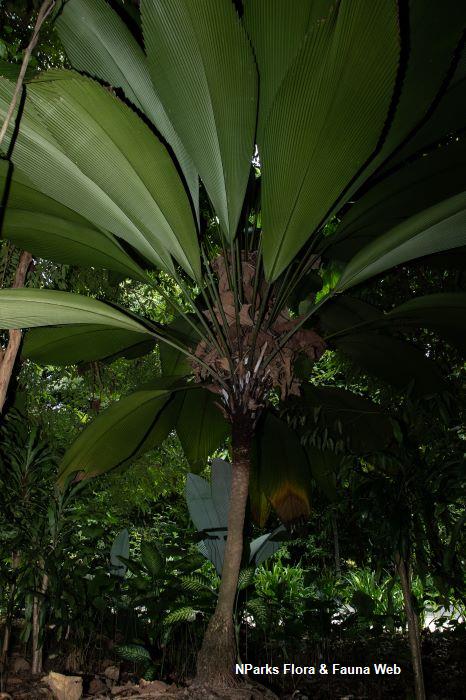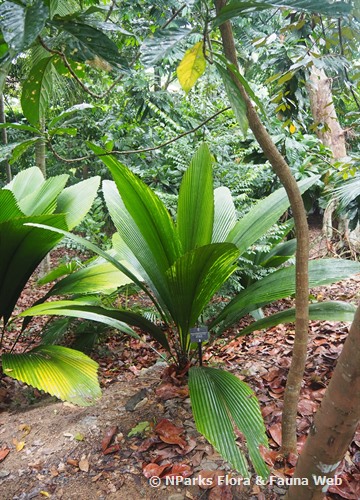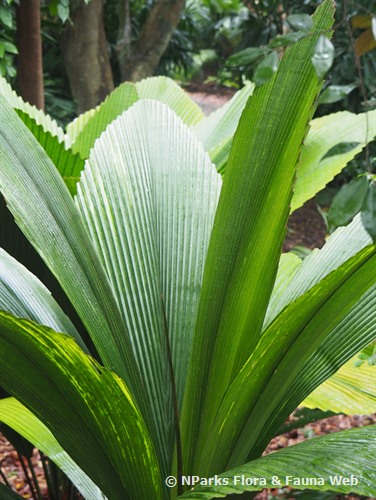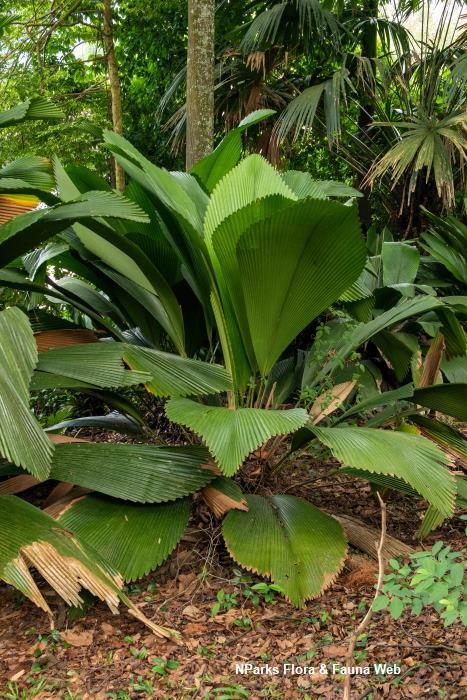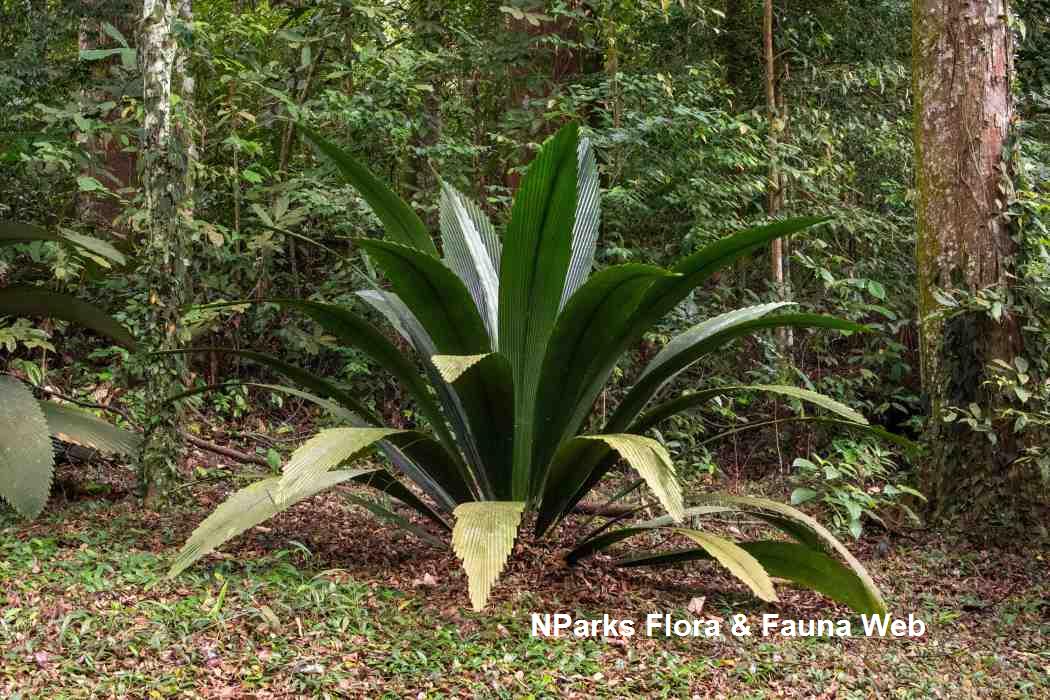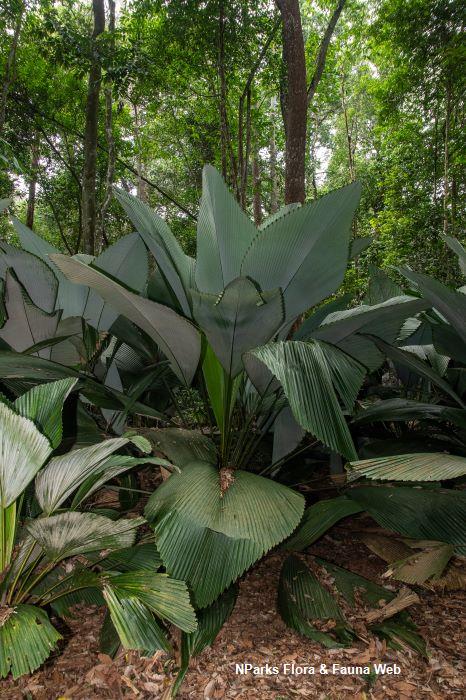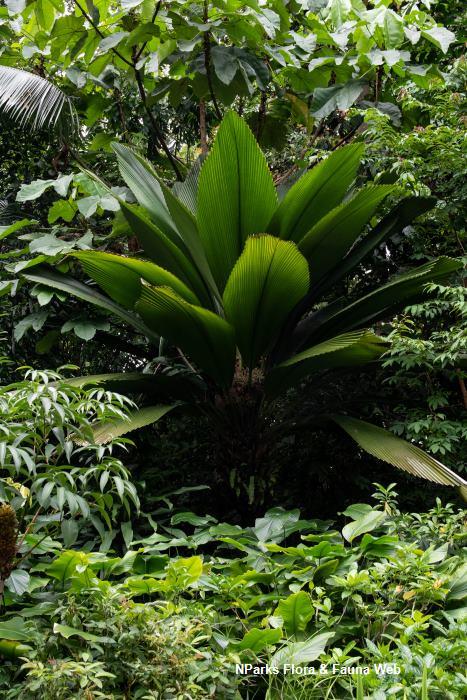
Back
Johannesteijsmannia perakensis J.Dransf.
| Family Name: | Arecaceae (Palmae) |
| Common Name: | Joey on a stick, Daun Payung, Belawan |
Johannesteijsmannia perakensis, or also known as Joey on a Stick, is a solitary, understorey palm found in Peninsular Malaysia. The common name arises from its the stem that can reach up to 4 m in height, unlike the other 'stemless' Johannesteijsmannia species. It produces large, pleated, narrowly diamond-shaped, undivided fronds that can reach up to 4 m in length, and an arching cluster of minute, white odorous flowers. The palm prefers well-drained soils and a humid, shaded environment.
Name
Classifications and Characteristics
| Plant Division | Angiosperms (Flowering Seed Plants) (Monocotyledon) |
|---|---|
| Plant Growth Form | Palm (Solitary Habit) |
| Lifespan (in Singapore) | Perennial |
| Mode of Nutrition | Autotrophic |
| Maximum Height | 4 m to 8 m |
Biogeography
| Native Distribution | Peninsular Malaysia |
|---|---|
| Native Habitat | Terrestrial (Primary Rainforest) |
| Preferred Climate Zone | Tropical |
| Local Conservation Status | Non-native (Horticultural / Cultivated Only) |
Description and Ethnobotany
| Growth Form | It is a slow-growing, solitary palm reaching 4 - 8 m in height. The palm is observed to have a litter-trapping habit, funnelling leaf litter and debris between the petioles (leaf stalks). |
|---|---|
| Foliage | The undivided fronds are large (up to 3 m long × 1.6 m wide), pleated, erect, and narrowly diamond-shaped. The undersides are smooth with soft, brown scales along the midrib, and the frond margin is armed with small, sharp thorns (up to 1 mm). The petiole (leaf stalk) is long (up to 1 m long × 2 cm wide), marked with two lateral yellow stripes and armed with small, sharp thorns. |
| Stems | It is acaulescent (seemingly stemless, with non-visible stems in palms) or with a relatively short stem when young. The stem can eventually reach 4 m in height × 15 cm in diameter. |
| Flowers | The inflorescence is an interfoliar (borne between the leaves/fronds) arching panicle, and subtended by 5 - 6 spathes or peduncular bracts. The spathes are covered in scruffy fuzz that starts cream-coloured before turning brown. The peduncle (central stalk on inflorescence) can be up to 50 cm long × 2 cm wide and branches up to 4 orders with 50 - 100 floriferous, divaricating (wide spreading), greenish, tomentose branches up to 10 cm long × 2.5 cm in diameter. The bisexual flowers occur singly or in groups of twos or threes, and are arranged spirally throughout each rachillae (minor, secondary axes on inflorescences). The flowers are white, fleshy, smooth, and odorous, emitting a strong, sweet or sour scent. |
| Fruit | The fruit is a globose, dirty-brown, drupe (a fleshy fruit with thin skin and a single central seed), up to 5 cm in diameter, with numerous corky protuberances that are 9 mm in height. |
| Habitat | It can be found on hill slopes and ridge tops in hill dipterocarp forests, ranging from 175 - 180m above sea level. It is predominantly found in primary forests. |
| Similar | This species can be distinguished from the similar-looking Johannesteijamannia altifrons by the visibly tall stem, divaricating branches of the inflorescence, and more corky protuberances on the fruit. <2> |
| Associated Fauna | The flowers are likely pollinated by stingless bees (genus Trigona). <1> |
| Cultivation | It requires bright, filtered light or dappled shade, moist, well-drained soil, and a damp, humid environment. Avoid strong winds and root disturbance, as it will stress the palm. It can be propagated by seeds. |
| Etymology | The genus epithet Johannesteijsmannia is name in honour of Johannes Elias Teijsmann, a 19th Century Dutch gardener and botanist at the former Buitenzorg Botanical Garden, Java (now Kebun Raya Indonesia, Bogor). The specific epithet perakensis refers to its locality in Perak, a province in Malaysia. |
| Ethnobotanical Uses | Others: The fronds are used as roof thatching for aboriginal huts in Peninsular Malaysia. The young endosperm is reputedly edible. |
Landscaping Features
| Landscaping | It is suitable for growing in parks under shady, humid conditions. It can be grown as a focal plant for its handsome form and attractive, narrowly diamond-shaped fronds. Avoid areas with strong winds, such as exposed areas and high-traffic roadsides. |
|---|---|
| Desirable Plant Features | Ornamental Foliage, Ornamental Form |
| Landscape Uses | Focal Plant, Parks & Gardens, Container Planting |
| Thematic Landscaping | Naturalistic Garden |
| Usage Hazard - Cons | Spines/Thorns - Leaf |
| Usage Hazard - Cons Remarks | Spines/Thorns (Leaf): The frond margin and petiole are lined with short spines. |
Fauna, Pollination and Dispersal
| Pollination Method(s) | Biotic (Fauna) (Insects (Bee)) |
|---|
Plant Care and Propagation
| Light Preference | Semi-Shade, Full Shade |
|---|---|
| Water Preference | Moderate Water |
| Plant Growth Rate | Moderate |
| Rootzone Tolerance | Well-Drained Soils, Fertile Loamy Soils |
| Transplanting Tolerance | Poor / Sensitive |
| Propagation Method | Seed |
Foliar
| Foliage Retention | Evergreen |
|---|---|
| Mature Foliage Colour(s) | Green |
| Mature Foliage Texture(s) | Glossy / Shiny, Leathery |
| Foliar Type | Simple / Unifoliate |
| Foliar Arrangement Along Stem | Spiral |
| Foliar Attachment to Stem | Petiolate |
| Foliar Shape(s) | Palm Fronds (Simple) |
| Foliar Venation | Parallel |
| Foliar Margin | Serrate / Toothed |
| Leaf Area Index (LAI) for Green Plot Ratio | 2.5 (Palm - Solitary) |
Non - Foliar and Storage
| Trunk Type (Palm) | Aboveground, Solitary Habit |
|---|---|
| Root Type | Underground (Fibrous Root) |
Floral (Angiosperm)
| Flower & Plant Sexuality | Bisexual Flowers |
| Flower Colour(s) | White |
|---|---|
| Flower Texture(s) | Smooth, Thick / Fleshy |
| Flower Grouping | Cluster / Inflorescence |
| Flower Location | Axillary |
| Flower Symmetry | Radial |
| Inflorescence Type | Panicle |
| Ovary Position | Superior / Hypogynous |
| Flowering Habit | Polycarpic |
Fruit, Seed and Spore
| Mature Fruit Colour(s) | Brown |
|---|---|
| Mature Fruit Texture(s) | Bumpy / Tuberculate |
| Fruit Classification | Simple Fruit |
| Fruit Type | |
| Seed Quantity Per Fruit | Few (1-5) |
References
| References | <1> Chan, Y.M., & Saw, L.G. (2011). Notes on the Pollination Ecology of the Palm Genus Johannesteijsmannia (Arecaceae). Journal of Pollination Ecology, 6(15). pp 108–117
<2> Dransfield, J. (1972). The Genus Johannesteijsmannia H. E. Moore Jr. Gardens' Bulletin, Singapore Vol. 26. pp 63–83. <3> Zona, S., & Christenhusz, M. J. M. (2015). Litter-trapping plants: Filter feeders of the plant kingdom. Botanical Journal of the Linnean Society, 179, pp 554–586. |
|---|
Image Repository
Others
| Master ID | 30035 |
|---|---|
| Species ID | 4344 |
| Flora Disclaimer | The information in this website has been compiled from reliable sources, such as reference works on medicinal plants. It is not a substitute for medical advice or treatment and NParks does not purport to provide any medical advice. Readers should always consult his/her physician before using or consuming a plant for medicinal purposes. |

